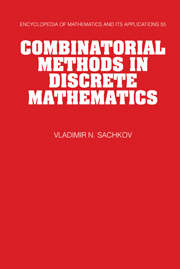1 - Combinatorial configurations
Published online by Cambridge University Press: 22 March 2010
Summary
The first section of this chapter is of an introductory nature and presents a summary of the main notions and results from the set theory and algebra which will be used in the book. In the sections that follow we consider various combinatorial configurations which may be introduced on the basis of the general notion of a configuration given in terms of mappings of sets. As examples of combinatorial configurations we consider Latin squares, orthogonal Latin squares, block designs and finite projective planes.
Notions of set theory and algebra
Boolean operations on sets
A set is a collection of elements of abstract nature, objects or notions, united by some common property. Along with the word “set” we sometimes use equivalent words such as “collection”, “family”, etc. A set consists of elements, and the formula x ∈ X means that the element x belongs to the set X; otherwise we write x ∉ X. If for each x ∈ X the inclusion x ∈ Y holds, then we say that X is a subset of Y and write X ⊆ Y. Sets X and Y are equal if X ⊆ y and Y ⊆ X. We say that a set X is a proper subset of Y and write X ⊂ Y if X ⊆ y and X ≠ Y. Any set contains, as a subset, the empty set denoted by ø.
- Type
- Chapter
- Information
- Combinatorial Methods in Discrete Mathematics , pp. 1 - 48Publisher: Cambridge University PressPrint publication year: 1996

